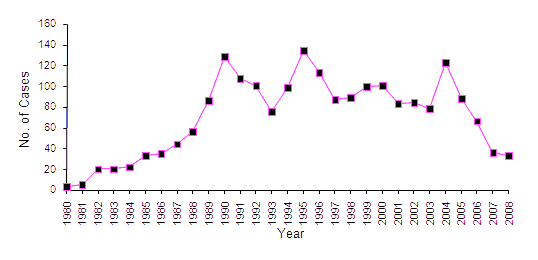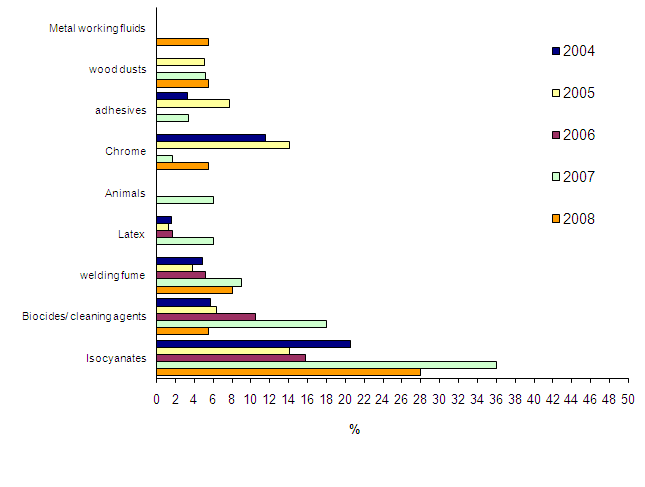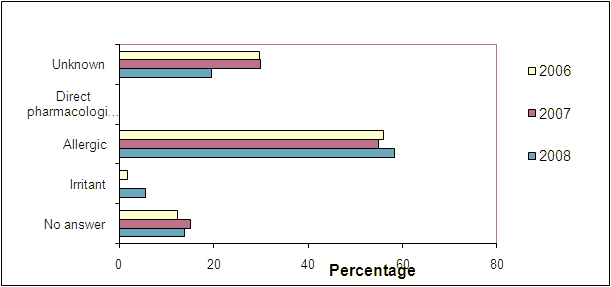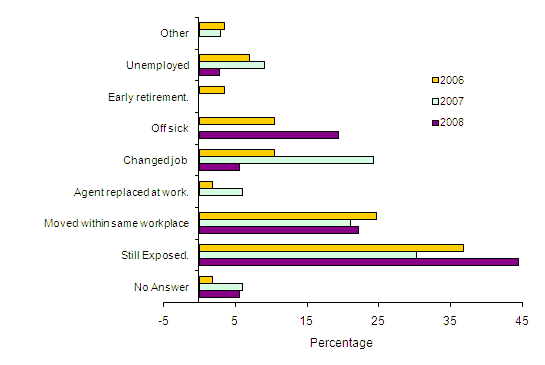Shield Report 2008; A surveillance scheme of occupational asthma in the Midlands |

|
C BURGE, VC Moore, S Manney, AS Robertson, MS Jaakkola, AD Vellore and PS Burge.
Occupational Lung Disease Unit, Heartlands Hospital, Bordesley Green East, Birmingham B9 5SS
SHIELD is the Midland Thoracic Society’s Surveillance Scheme for
Occupational Asthma for the West Midlands. The scheme, which was set up
in January 1989, was established to study the general and specific
incidence of occupational asthma within the West Midlands region and
Metropolitan County. The rate of reporting increased sharply in 2004,
mainly due to a major outbreak, but since then we have seen a steady
decrease in reports with 2007/2008 having the lowest number so far with only
36 reports each. We believe this is likely to be short lived however, with
reports rising soon.
The most common cause in 2008 was isocyanates (28%). Welding Fumes came second at 8%. There were no reports of Latex, suggesting that substitution of latex gloves is continuing.
91% of cases reported in 2008 were by the Birmingham Chest Clinic
and 9% by others. We hope to increase the number notified by others
this year by using the MTS website to contact notifiers. The most common method
for the diagnosis of occupational asthma still remains a history of
improvement of symptoms during holidays or periods off work. Some form
of objective confirmation was sought in 94% of patients showing
improvement away from work.
We
still have plans for developing the Shield Database. This may be with
web based reporting or in conjunction with a new version of Oasys to be
used via the internet. There are higher
priorities on the agenda and the plans remain in limbo at the moment.
Introduction
Shield is a joint project between the West Midlands branch of the
Society of Occupational Medicine and the Midland Thoracic Society. The
scheme, which was set up in January 1989, was established to meet three
main objectives. 1) To study the general and specific incidence of
occupational asthma within a defined geographic area, 2) To determine
proposed mechanisms of asthma, and 3) to audit diagnostic methods and
objectives. Chest physicians and members of the West Midlands Group of
the Society of Occupational Medicine implemented the scheme, by
reporting each new case using a questionnaire format. The questionnaire
covers confidential personal information on the patient, details of the
diagnosis, information about their occupational history, and the
outcome after diagnosis.
The last report on Shields progress was written in 2007 and
summarised the information gained in that year, to that of previous
years, 2006 and 2005. This report aims to update the participants of
Shield by summarising the trends found in 2008 compared to those found
in 2007 and 2006.
Outbreak of the year
We have had 12 notifications from a manufacturer of car seats which involves injection of isocyanates into a mould. The process is automated, the main exposures are likely to occur when the foam is removed from the moulds. Following an index case in 1999 there have been sporadic cases until this year when we have had 3 notifications. There have also been 2 more notifications in January 2009 (not included in this report). Relocation to the warehouse was only partially effective as workers still had to walk through the main factory for meals, toilets etc. Injection moulding of polyurethane foam is a well recognised cause of occupational asthma, which poses problems for exposure control.
Agent Awareness
We were surprised to find that thiamine sprayed onto cereals was the cause of occupational asthma of a worker identified in 2004. Since then we have heard of three further cases. We have used the asthma hazard prediction program (developed by Martin Seed et al at Manchester) to look at other vitamins, many of which had chemical structures that suggested that they were occupational allergens if inhaled.
Shield Data
Number of Cases
The number of cases of occupational asthma reported to the Shield
scheme is 36 so far. When the SHIELD report for 2007 was written, there
were 33 cases notified, but now this figure is up to 36. It is
difficult to compare notification for each year properly, as the last
few years are likely to change, therefore the graph below is only as a
guideline.
Figure 1 Number of cases diagnosed with occupational asthma between the years of 1980 and 2008

Personal details
In the year of 2008, 36 new cases have been reported to the scheme
so far. There were 28 males (85 %), and 5 females (15 %). 26 (84%) of
the new cases had no pre-existing asthma, and 13 (42%) had never smoked.
Reporting Hospital and Physician
The Shield scheme is confined to the West Midlands Region and the
West Midlands Metropolitan County. In this region there are many chest
physicians, hospitals, clinics and other organisations, which are known
to the Shield scheme. However, many of these have not been asked to
report over the last year due to the data protection issues. Therefore,
in 2008, 30 (91 %) of the cases reported to Shield were through the
Birmingham Chest Clinic, and 3 (9%) through other organisations. We are
hoping that there will be more cases reported from other institutions
in the coming year.
Suspected agents at work
In 2008 the most common reported agent that workers were exposed to
was isocyanates (28%). The 2 most common in 2007 were isocyanates and biocides / cleaning agents (36% and 18% respectively). isocyanates were also the most common in
2006. 447 cases of isocyanate
suspected asthma have now been reported to the scheme, the first case
being in 1978. Metal exposed cases are low and stable with only 2
notifications being made in 2008.
The top six agents reported in 2008 were;
- Isocyanates 28% 10 cases
- Welding Fumes 8% 3 cases
- Biocides / Cleaning Agents 6% 2 cases
- Wood Dusts 6% 2 cases
- Metal Working Fluids 6% 2 cases
- Chrome 6% 2 cases
Figure 2 Comparison of the percentage of patients exposed to the top five agents in 2008 to those exposed in 2007-2004.

Employers and Jobs
There were 31 different employers reported to the scheme in 2008. 18 of these were new to the scheme.
Around 30 different jobs were reported in 2008, although it would be
possible to group some of the specific jobs into broader categories
(e.g. teachers). The most common job was "Packer" at 12%
of all notifications in 2008.
Table 1 A list of the most common agents reported in 2008 with the corresponding jobs
| Agent Exposed |
Job |
| Isocyanates |
Accountant, Paint Sprayer, Cleaner, Engineer, Packer, Foamer, Moulder
|
| Welding fume |
Press setter, Inspector, Welder
|
| Biocides/Cleaning agents |
Vending machine servicer, Administrator
|
Wood dusts
|
Clerk, Joiner
|
Metal Working Fluids
|
Grinder / Machinist
|
Methods used for diagnosis
The methods used for diagnosis that are documented on the shield
form are; 1) Improvement on holiday, 2) Improvement off work, 3) Serial
peak flow charts, 4) Specific IgE, 5) Methacholine at work, and 6)
Methacholine away from work and 7) Specific bronchial provocation
tests. 32 cases were documented as improving off work and on holidays.
Of these, 30 cases had at least one other investigation. The most
common investigation was serial peak flow charts (29 cases) followed by
specific IgE (19 cases). There were 8 specific challenges performed on patients diagnosed in 2008.
Table 2 Percentage use of each method of diagnosing occupational asthma in 2008, 2007 and 2006.
| Method |
% 2008 |
% 2007 |
% 2006 |
| Improving on holidays |
92
|
91 |
93
|
| Improving off work |
89
|
85 |
82
|
| Serial peak flow |
81
|
70
|
67
|
| Specific IgE |
53
|
45
|
37
|
| Methacholine at work |
58
|
39
|
46
|
| Methacholine away from work |
31
|
33
|
26 |
Specific Bronchial Challenge
(positive challenges) |
8 (2)
|
15
(6) |
7
(3.5) |
Proposed method of asthma
Figure 3 shows the proposed mechanism of asthma in patients with
diagnosed occupational asthma in 2008, 2007 and 2006. In 2008 the most
commonly reported mechanisms of asthma were allergic (58 %) and unknown
(19 %). In 2007 allergic and unknown mechanisms were also reported in
most cases (55% and 30% respectively). The percentage of ‘no answer’
has fallen slightly in 2008 to 14% from 15% in 2006 and an average of 11%
over the 2 years before that. The other mechanisms (irritant and direct
pharmacological effect) have hardly been used this year.
Figure 3 Proposed mechanisms of asthma in 2008, 2007 and 2006

Subsequent History
The subsequent history of the patients diagnosed with occupational
asthma in 2008 is shown in Figure 4. There are a similar amount of
workers remaining exposed and moving within the same workplace. The number off sick has increased
this year and the amount that have changed job has fallen. Relocation at work
probably remains the most effective solution in most cases. The
recorded subsequent history of the patient is taken at diagnosis and is
subject to change so these figures will change with time.
Figure 4 Subsequent history of patients diagnosed of occupational asthma in 2008, 2007 and 2006

Gold Standards
A gold standard occupational asthma case is defined by either; 1)
Bronchial challenge test, 2) A four fold change in their bronchial
reactivity with a good history, or 3) Positive IgE with a good history,
and all of these can be accompanied by a good quality PEF record. 6%
of cases have become gold standards in 2008 so far.
Future Developments
The BTS standards of care for occupational asthma have recently been
published (Fishwick D et al. Standards of care for occupational asthma,
Thorax, 2008; 63 : 240-250). It recommends auditing the following items
which have now been added to the Shield report form. See Standards of care for occupational asthma for more information and full paper.
All patients with suspected occupational asthma should have the
following clearly documented in the medical case notes by the second
consultation:
- A full list of occupations held and likely associated occupational exposures.
- FEV1 and FVC.
- If
at work, serial PEF measures taken for at least four continuous weeks
including rest days with at least four good quality readings per day
analysed by a validated method.
- If exposed to allergen with appropriate specific IgE measure or skin prick test, the result of this test.
- Letter to patient concerning advice about continuing employment once a diagnosis has been made.
- Compensation advice appropriate to the case.
The problems with the Shield scheme are lack of reporting, a need
for constant updating and a lack of resources. We have solved the data
protection issues and will start to request notifications from other
institutions. We would like to add web based reporting to improve
notification and updating but this is on hold for the time being due to
time constraints. There are organisational and technical changes to be
made to improve accuracy and to help keep data up to date. We have
plans for these but there is no date set for implementation as yet. The
Midlands Thoracic Society has a new website which will make it easier to contact Shield Notifiers. At the moment there are a limited number of people using this website and only these people are contactable. This should improve with time. The Oasys program is being developed to work through the internet in an attempt to make the Oasys project self funding. This may present opportunities to enhance data collection for Shield.
Conclusions
Occupational asthma remains a serious disease causing much
morbidity, and is potentially preventable. The Health and Safety
Executive are currently emphasising the need to control occupational
asthma. Workers in small paint shops are among those who have been most
reported this year and should be studied to assess the development of
occupational asthma.
Comments
Cedd and Sherwood, glad to see Shield is still up and running.
Do you think the drop in reports is due to a real drop in the incidence of OA or a drop in reporting?
What was the accountant doing with isocyantes??
Paul
|
|
Hi Paul. Latex and Glutaraldehyde seem to be largely sorted out so there are less reports from these. We have also found another 9 shield reports for 2008 that came through too late for the report. There is probably a small real drop in incidence. We have two less doctors in the clinic to see patients at the moment so are reporting a lot less as well.
|
|
Ps. Our accountant had bystander exposure to spray paint operation often carried out outside the booth next to her office.
|
Please sign in or register to add your thoughts.